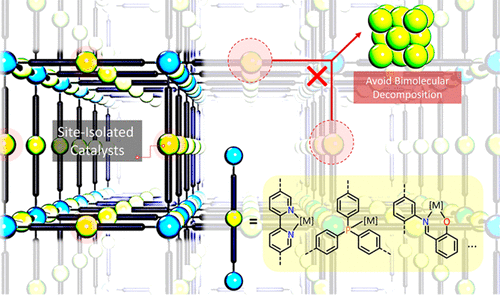当前位置:
X-MOL 学术
›
Acc. Chem. Res.
›
论文详情
Our official English website, www.x-mol.net, welcomes your feedback! (Note: you will need to create a separate account there.)
Site Isolation in Metal–Organic Frameworks Enables Novel Transition Metal Catalysis
Accounts of Chemical Research ( IF 18.3 ) Pub Date : 2018-08-21 00:00:00 , DOI: 10.1021/acs.accounts.8b00297 Tasha Drake 1 , Pengfei Ji 1 , Wenbin Lin 1
Accounts of Chemical Research ( IF 18.3 ) Pub Date : 2018-08-21 00:00:00 , DOI: 10.1021/acs.accounts.8b00297 Tasha Drake 1 , Pengfei Ji 1 , Wenbin Lin 1
Affiliation

|
Comprising periodically repeating inorganic nodes and organic linkers, metal–organic frameworks (MOFs) represent a novel class of porous molecular solids with well-defined pores and channels. Over the past two decades, a large array of organic linkers have been combined with many inorganic nodes to afford a vast library of MOFs. The synthetic tunability of MOFs distinguishes them from traditional porous inorganic materials and has allowed the rational design of many interesting properties, such as porosity, chirality, and chemical functionality, for potential applications in diverse areas including gas storage and separation, catalysis, light harvesting, chiral separation, and chemical sensing. In particular, the molecular functionality and intrinsic porosity of MOFs have rendered them attractive candidates as porous single-site solid catalysts for a large number of organic transformations. MOF catalysts offer several advantages over their homogeneous counterparts, including enhanced stability, recyclability and reusability, and facile removal of the toxic catalyst components from the organic products. Additionally, the highly ordered nature of MOFs leads to the generation of single-site solid catalysts, allowing for precise characterization of the catalytic sites through X-ray diffraction, X-ray absorption, and other spectroscopic interrogations and facilitating the elucidation of reaction mechanisms. Thus, MOF catalysis represents a fertile research area that is expected to witness continued growth in the foreseeable future. In this Account, we present our recent research progress in developing ligand-supported single-site MOF catalysts for challenging organic reactions. We present two complementary approaches to the design of ligand-supported MOF catalysts: direct incorporation of prefunctionalized organic linkers into MOFs and postsynthetic functionalization of orthogonal secondary functional groups of the organic linkers in MOFs. Monophosphine-, bipyridine-, β-diketimine-, and salicylaldimine-based ligands have been used to support both precious (Pd, Pt, Ir, Ru) and earth-abundant (Cu, Co, Fe) metals for a number of interesting catalytic reactions. The resulting MOF catalysts feature stable low-coordination species with minimum steric bulk around the active site—a feat that remains a challenge for homogeneous catalysts. For each ligand, we describe types of reactions catalyzed by the MOF in comparison with its homogeneous counterpart. In all cases, MOF catalysts outperformed their homogeneous counterparts in terms of catalyst stability, catalytic activity, and recyclability and reusability. Interestingly, several bipyridine- and salicylaldimine-ligated earth-abundant-metal-based MOF catalysts do not have homogeneous counterparts because the molecular compounds disproportionate or oligomerize to form inactive species in solution. This Account not only presents several interesting designs of ligand-supported single-site MOF catalysts but also provides illustrative examples of how site isolation in MOF catalysts shuts down deactivation pathways experienced by homogeneous systems. With precise knowledge of MOF structures and catalytically active sites, we envision the development of practically useful MOF catalysts comprising tailor-made building blocks that rationally optimize catalytic activities and selectivities.
中文翻译:

金属有机框架中的位点隔离实现了新型的过渡金属催化
金属-有机骨架(MOF)由周期性重复的无机节点和有机连接基组成,代表了一类新型的多孔分子固体,具有明确的孔和通道。在过去的二十年中,大量的有机连接基与许多无机节点结合在一起,以提供庞大的MOF库。MOF的合成可调性使其与传统的多孔无机材料区分开来,并允许合理设计许多有趣的特性,例如孔隙率,手性和化学功能性,可在各种领域中潜在应用,包括气体存储和分离,催化,光收集,手性分离和化学传感。尤其是,MOF的分子官能度和固有孔隙率使其成为用于大量有机转化的多孔单中心固体催化剂的诱人候选物。MOF催化剂比其均相催化剂具有几个优势,包括增强的稳定性,可回收性和可重复使用性,以及从有机产品中轻松去除有毒催化剂组分的能力。另外,MOF的高度有序性导致单中心固体催化剂的产生,从而可以通过X射线衍射,X射线吸收和其他光谱学询问来精确表征催化位点,并有助于阐明反应机理。因此,MOF催化代表了一个肥沃的研究领域,有望在可预见的将来持续增长。在这个帐户中,我们介绍了我们在开发用于挑战性有机反应的配体支持的单中心MOF催化剂方面的最新研究进展。我们提出了两种互补的方法来设计由配体支撑的MOF催化剂:将预先官能化的有机连接基直接掺入MOF,以及将有机连接基中的正交次级官能团合成后官能化。单膦基,联吡啶基,β-二酮亚胺基和水杨醛亚胺基配体已被用于支持贵金属(Pd,Pt,Ir,Ru)和地球上丰富的(Cu,Co,Fe)金属,从而产生了许多有趣的催化作用反应。所得的MOF催化剂具有稳定的低配位物种,在活性位点附近具有最小的空间体积,这一壮举仍然是均相催化剂所面临的挑战。对于每个配体,我们描述了MOF与其均相对应物相比催化的反应类型。在所有情况下,MOF催化剂在催化剂稳定性,催化活性以及可回收性和可重复使用性方面均优于同类均质催化剂。有趣的是,几种联吡啶和水杨醛亚胺连接的基于地球的金属富集的MOF催化剂没有均相的对应物,因为分子化合物歧化或低聚形成了溶液中的惰性物质。该帐户不仅介绍了配体负载的单中心MOF催化剂的几种有趣设计,而且还提供了MOF催化剂中位点隔离如何关闭均相系统经历的失活途径的说明性示例。借助MOF结构和催化活性位点的精确知识,
更新日期:2018-08-21
中文翻译:

金属有机框架中的位点隔离实现了新型的过渡金属催化
金属-有机骨架(MOF)由周期性重复的无机节点和有机连接基组成,代表了一类新型的多孔分子固体,具有明确的孔和通道。在过去的二十年中,大量的有机连接基与许多无机节点结合在一起,以提供庞大的MOF库。MOF的合成可调性使其与传统的多孔无机材料区分开来,并允许合理设计许多有趣的特性,例如孔隙率,手性和化学功能性,可在各种领域中潜在应用,包括气体存储和分离,催化,光收集,手性分离和化学传感。尤其是,MOF的分子官能度和固有孔隙率使其成为用于大量有机转化的多孔单中心固体催化剂的诱人候选物。MOF催化剂比其均相催化剂具有几个优势,包括增强的稳定性,可回收性和可重复使用性,以及从有机产品中轻松去除有毒催化剂组分的能力。另外,MOF的高度有序性导致单中心固体催化剂的产生,从而可以通过X射线衍射,X射线吸收和其他光谱学询问来精确表征催化位点,并有助于阐明反应机理。因此,MOF催化代表了一个肥沃的研究领域,有望在可预见的将来持续增长。在这个帐户中,我们介绍了我们在开发用于挑战性有机反应的配体支持的单中心MOF催化剂方面的最新研究进展。我们提出了两种互补的方法来设计由配体支撑的MOF催化剂:将预先官能化的有机连接基直接掺入MOF,以及将有机连接基中的正交次级官能团合成后官能化。单膦基,联吡啶基,β-二酮亚胺基和水杨醛亚胺基配体已被用于支持贵金属(Pd,Pt,Ir,Ru)和地球上丰富的(Cu,Co,Fe)金属,从而产生了许多有趣的催化作用反应。所得的MOF催化剂具有稳定的低配位物种,在活性位点附近具有最小的空间体积,这一壮举仍然是均相催化剂所面临的挑战。对于每个配体,我们描述了MOF与其均相对应物相比催化的反应类型。在所有情况下,MOF催化剂在催化剂稳定性,催化活性以及可回收性和可重复使用性方面均优于同类均质催化剂。有趣的是,几种联吡啶和水杨醛亚胺连接的基于地球的金属富集的MOF催化剂没有均相的对应物,因为分子化合物歧化或低聚形成了溶液中的惰性物质。该帐户不仅介绍了配体负载的单中心MOF催化剂的几种有趣设计,而且还提供了MOF催化剂中位点隔离如何关闭均相系统经历的失活途径的说明性示例。借助MOF结构和催化活性位点的精确知识,



























 京公网安备 11010802027423号
京公网安备 11010802027423号